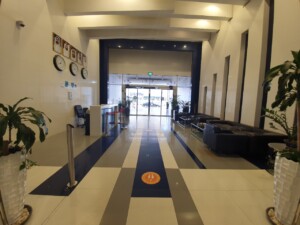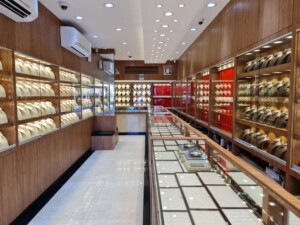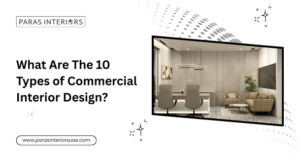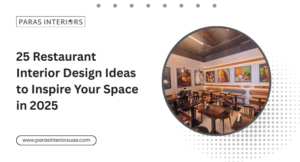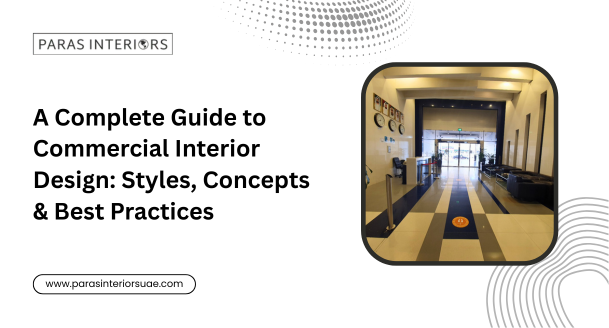
A Complete Guide to Commercial Interior Design: Styles, Concepts & Best Practices
Commercial interior design plays a vital role in shaping how businesses function, communicate their brand, and create impactful environments for employees, customers, and stakeholders. Unlike residential interiors that focus on comfort and personal style, commercial interior design prioritizes functionality, branding, and adaptability to enhance productivity and customer experiences.
This guide explores the foundational elements, diverse styles, and future trends influencing commercial interiors, along with expert tips to achieve success in interior commercial design.
What is Commercial Interior Design?
Commercial vs. Residential Interior Design
While residential design is about creating comfortable living spaces, commercial interior design is centered on spaces used for business purposes. Offices, retail stores, restaurants, healthcare facilities, and hospitality venues each require tailored solutions that blend aesthetics with high performance.
Definition and Scope of Interior Design for Commercial Spaces
Interior design for commercial spaces involves planning and executing functional, visually appealing environments where businesses operate effectively. From space planning and furniture selection to incorporating advanced technologies, the scope of work ensures the design supports both the brand and occupants’ needs.
Importance of Interior Commercial Design in Business Identity
Design strongly influences how a business is perceived. For instance, an office designed with clean lines and tech-forward elements conveys innovation, while a café with cozy décor and biophilic features provides an inviting ambiance. Strategic commercial design directly impacts employee morale, consumer behavior, and business success.
Common Types of Commercial Interiors
Retail Interior Design
Commercial retail interior design focuses on creating visually engaging store layouts that attract customers and improve their shopping experience. Key elements include well-placed displays, strategic lighting, and intuitive navigation for an immersive retail environment.
Office Interior Design
The design of commercial office spaces prioritizes productivity, collaboration, and employee well-being. Open-plan layouts, ergonomic furniture, and dynamic workspaces are essential to modern office environments.
Hospitality & Restaurant Interiors
Hospitality interiors in hotels, bars, and restaurants emphasize guest experiences. They combine comfort with aesthetic appeal, ensuring every design element—from the lighting to the seating—reflects the brand’s identity.
Healthcare & Educational Institutions
Interior design for commercial spaces like hospitals or schools aims for functionality while promoting healing or learning. Sustainable materials, optimal lighting, and calming aesthetics contribute to practical yet welcoming spaces.
Commercial Building Interior Design for Mixed-Use Projects
Commercial building interior design often caters to multi-use developments that blend retail, dining, offices, and residential elements. Each space within these complexes must harmonize in terms of both utility and style.
Core Elements of Successful Commercial Interior Design
Functionality and Workflow Optimization
Functional designs prioritize spatial efficiency and workflows to ensure businesses run smoothly. For example, a restaurant’s kitchen layout focuses on seamless flow between prep, cooking, and serving areas.
Branding Through Interior Design
A well-designed commercial space communicates brand values. Color schemes, logo displays, and custom furniture inspired by a company’s identity help establish consistency and foster recognition.
Use of Lighting, Space, and Color Psychology
Lighting sets the mood, while space planning influences usability. Additionally, color psychology plays a significant role in evoking emotions—for instance, greens for tranquility or reds for energy in retail settings.
Smart Technology Integration in Commercial Spaces
From automated lighting to advanced security systems, smart solutions enhance functionality, efficiency, and the user experience in modern commercial interior design.
Sustainability and Eco-Friendly Materials
The demand for sustainable commercial design continues to grow. Eco-friendly materials such as reclaimed wood, bamboo, or non-toxic paints help businesses meet environmental goals without compromising aesthetics.
Popular Commercial Interior Design Styles
Modern Commercial Interior Design
This style employs sleek architecture, minimal embellishments, and a neutral color palette to create contemporary spaces that feel both professional and trendy.
Minimalist & Open-Concept Layouts
Minimalism prioritizes simplicity, using uncluttered designs and open spaces to create functionality. Open layouts are particularly beneficial in multi-use spaces like coworking hubs.
Industrial & Urban Styles
Industrial styles leverage raw materials such as concrete, brick, and exposed pipes. These elements, along with repurposed furniture, create urban-inspired interiors perfect for creative businesses.
Biophilic and Wellness-Centric Design
Biophilic interiors integrate natural elements like greenery, natural light, and ventilation. Wellness-centric designs prioritize occupant health, making these styles ideal for workplaces and healthcare providers.
Design Tips for Different Commercial Spaces
Interior Design Commercial Office Space Layout Tips
To optimize productivity, separate quiet zones from collaborative areas. Equip spaces with adjustable standing desks and breakout lounges. Ergonomic lighting also prevents screen burnout, improving employee comfort.
Commercial Retail Interior Design Ideas to Attract Customers
Create focal points through window displays, organize spaces to lead customers toward key products, and use ambient lighting to craft an inviting atmosphere.
Interior Commercial Design for Hospitality and Dining
Use statement furniture, dramatic lighting, and thematic décor to set the tone for dining experiences. Custom furniture tailored to maximize seating without overcrowding is essential.
Commercial Building Interior Design Ideas for Multi-use Environments
Blend cohesive aesthetics with adaptable layouts. Introduce multifunctional furniture and integrated technologies for a dynamic, user-friendly space.
The Process of Commercial Interior Designing
Needs Assessment and Space Planning
The first step is understanding client requirements and assessing how to optimize the space. Effective planning ensures practical layouts and a clear division of functions.
Moodboarding and Concept Development
Moodboards align the visual style with the client’s vision, incorporating color schemes, fixtures, and sample furniture to create a cohesive concept.
Procurement and Project Execution
After finalizing designs, sourcing materials and overseeing construction or renovations ensures the interior aligns with the conceptual framework.
Why Hire a Commercial Interior Design Firm?
Expertise in Workspace Compliance and Building Codes
Experienced designers know how to comply with industry regulations, ensuring safe and accessible designs.
Efficiency and Budget Management
Professional firms manage timelines and budgets efficiently, eliminating the risk of costly delays or overruns.
Access to Design Networks and Materials
Hiring experts unlocks access to exclusive materials, innovative furniture, and robust design networks, elevating the quality and uniqueness of the space.
Commercial Interior Design Trends in 2025
Flexible Workspaces & Hybrid Design
Future offices prioritize adaptability, offering shared desks, breakout rooms, and hybrid layouts to cater to evolving workforce needs.
Smart and Sustainable Interiors
Green technologies such as energy-efficient systems combined with sustainable materials are redefining market standards.
Bold Color Use & Artistic Statements
Vibrant color palettes combined with unique art installations will dominate commercial interior design styles, creating memorable and dynamic spaces.
Conclusion
Strategic commercial interior design enhances business operations while leaving lasting impressions on clients and customers. Investing in intentional layouts, branding elements, and innovative solutions ensures both practicality and ambiance.
Working with professional designers brings global trends, sustainability, and compliance expertise to your projects. Whether you’re planning a retail store or a hybrid office, expert collaboration transforms ideas into extraordinary experiences.
Frequently Asked Questions
Commercial interior design focuses on creating functional and visually appealing spaces for businesses, such as offices, retail stores, and restaurants. Unlike residential design, which centers on comfort and personal preferences, commercial design emphasizes functionality, branding, and accommodating group dynamics.
Interior design enhances the functionality, visual appeal, and branding of commercial spaces. A well-designed environment boosts employee productivity, improves customer experiences, and strengthens the overall identity of the business.
Common styles include:
- Modern design, which features sleek lines and minimal embellishments.
- Industrial style, known for its raw materials like concrete and exposed elements.
- Biophilic design, which incorporates natural elements to promote wellness.
- Minimalist design, focusing on simplicity and open layouts.
Branding is a key aspect of commercial design, using color schemes, logos, and custom furniture to reflect a business’s identity. Consistent design elements create a recognizable and memorable experience for customers and employees.
To optimize office layouts:
- Separate collaborative areas from quiet zones.
- Use ergonomic furniture for comfort.
- Incorporate natural light and greenery to enhance the working environment.
Professional firms bring expertise in compliance with building codes, efficient budget management, and access to exclusive materials. They ensure designs are both functional and visually appealing, tailored to a business’s unique needs.


